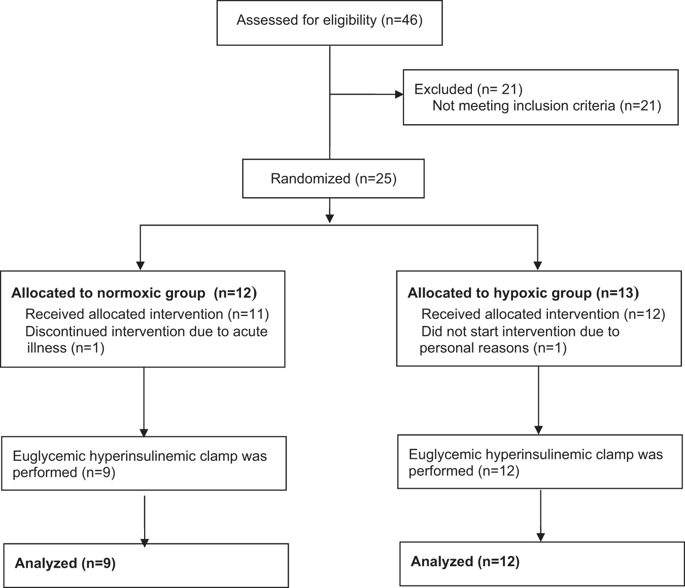当前位置:
X-MOL 学术
›
Int. J. Obesity
›
论文详情
Our official English website, www.x-mol.net, welcomes your
feedback! (Note: you will need to create a separate account there.)
Hypoxia and exercise interactions on skeletal muscle insulin sensitivity in obese subjects with metabolic syndrome: results of a randomized controlled trial.
International Journal of Obesity ( IF 4.2 ) Pub Date : 2019-12-09 , DOI: 10.1038/s41366-019-0504-z Knut Mai 1, 2, 3, 4, 5 , Lars Klug 1 , Natalia Rakova 1 , Sophie K Piper 5, 6 , Anja Mähler 1 , Thomas Bobbert 2 , Jeanette Schulz-Menger 1 , Joachim Spranger 1, 2, 3, 4 , Michael Boschmann 1 , Friedrich C Luft 1
International Journal of Obesity ( IF 4.2 ) Pub Date : 2019-12-09 , DOI: 10.1038/s41366-019-0504-z Knut Mai 1, 2, 3, 4, 5 , Lars Klug 1 , Natalia Rakova 1 , Sophie K Piper 5, 6 , Anja Mähler 1 , Thomas Bobbert 2 , Jeanette Schulz-Menger 1 , Joachim Spranger 1, 2, 3, 4 , Michael Boschmann 1 , Friedrich C Luft 1
Affiliation

|
BACKGROUND
Physical activity improves insulin sensitivity in obesity. Hypoxia training is claimed to augment this effect. We tested the hypothesis that normobaric hypoxia training would improve insulin sensitivity in obese patients with metabolic syndrome.
METHODS
In a randomized controlled trial, 23 obese men with metabolic syndrome who were not informed of the FiO2 conditions underwent a 6-week physical exercise intervention under ambient (n = 11; FiO2 21%) conditions or hypoxia (n = 12; FiO2 15%) using a normobaric hypoxic chamber. Three 60-min sessions of interval training were performed each week at 60% of individual V̇O2max. Assessment of myocellular insulin sensitivity by euglycemic hyperinsulinemic clamp was performed in 21 of these subjects before and after 6 weeks of training. Comprehensive phenotyping also included biopsies of subcutaneous adipose tissues.
RESULTS
The intermittent moderate physical exercise protocol did not substantially change the myocellular insulin sensitivity within 6 weeks under normoxic conditions (ISIClamp: 0.035 (IQR 0.016-0.075) vs. 0.037 (IQR 0.026-0.056) mg* kg-1 *min-1/(mU* l-1); p = 0.767). In contrast, ISIClamp improved during hypoxia training (0.028 (IQR 0.018-0.035) vs. 0.038 (IQR 0.024-0.060) mg * kg-1 *min-1/(mU *l-1); p < 0.05). Between group comparison of ISIClamp change revealed a small difference between groups (Cohen's d = 0.26). Within the hypoxic group, improvement of ISIClamp during training was associated with individual increase of circulating vascular endothelial growth factor (VEGF) levels (r = 0.678, p = 0.015), even if mean VEGF levels were not modified by any training condition. Atrial natriuretic peptide (ANP) system components were not associated with increased ISIClamp during hypoxic training.
CONCLUSIONS
Physical training under hypoxic conditions could partially augment the favorable effects of exercise alone on myocellular insulin sensitivity in obese men with metabolic syndrome. Concomitant changes in VEGF might represent an underlying pathophysiological mechanism.
中文翻译:

代谢综合征肥胖受试者骨骼肌胰岛素敏感性的缺氧和运动相互作用:随机对照试验的结果。
背景身体活动改善肥胖症的胰岛素敏感性。据称缺氧训练可以增强这种效果。我们检验了常压缺氧训练会改善患有代谢综合征的肥胖患者的胰岛素敏感性的假设。方法 在一项随机对照试验中,23 名未获知 FiO2 条件的代谢综合征肥胖男性在环境条件(n = 11;FiO2 21%)或缺氧条件(n = 12;FiO2 15)下接受了为期 6 周的体育锻炼干预%) 使用常压缺氧室。每周以 60% 的个体 V̇O2max 进行 3 次 60 分钟的间歇训练。在训练 6 周之前和之后,对这些受试者中的 21 名进行了正常血糖高胰岛素钳夹对肌细胞胰岛素敏感性的评估。综合表型还包括皮下脂肪组织活检。结果 在常氧条件下,间歇性适度体育锻炼方案在 6 周内并未显着改变肌细胞胰岛素敏感性(ISIClamp:0.035 (IQR 0.016-0.075) vs. 0.037 (IQR 0.026-0.056) mg* kg-1 *min-1/ (mU* l-1);p = 0.767)。相比之下,ISIClamp 在缺氧训练期间有所改善 (0.028 (IQR 0.018-0.035) vs. 0.038 (IQR 0.024-0.060) mg * kg-1 *min-1/(mU *l-1);p < 0.05)。ISIClamp 变化的组间比较显示组间差异很小(Cohen's d = 0.26)。在缺氧组中,训练期间 ISIClamp 的改善与循环血管内皮生长因子 (VEGF) 水平的个体增加有关(r = 0.678,p = 0.015),即使平均 VEGF 水平没有被任何训练条件改变。心房钠尿肽 (ANP) 系统组件与缺氧训练期间增加的 ISIClamp 无关。结论 缺氧条件下的体育锻炼可以部分增强单独运动对患有代谢综合征的肥胖男性肌细胞胰岛素敏感性的有利影响。VEGF 的伴随变化可能代表了潜在的病理生理机制。
更新日期:2019-12-11
中文翻译:

代谢综合征肥胖受试者骨骼肌胰岛素敏感性的缺氧和运动相互作用:随机对照试验的结果。
背景身体活动改善肥胖症的胰岛素敏感性。据称缺氧训练可以增强这种效果。我们检验了常压缺氧训练会改善患有代谢综合征的肥胖患者的胰岛素敏感性的假设。方法 在一项随机对照试验中,23 名未获知 FiO2 条件的代谢综合征肥胖男性在环境条件(n = 11;FiO2 21%)或缺氧条件(n = 12;FiO2 15)下接受了为期 6 周的体育锻炼干预%) 使用常压缺氧室。每周以 60% 的个体 V̇O2max 进行 3 次 60 分钟的间歇训练。在训练 6 周之前和之后,对这些受试者中的 21 名进行了正常血糖高胰岛素钳夹对肌细胞胰岛素敏感性的评估。综合表型还包括皮下脂肪组织活检。结果 在常氧条件下,间歇性适度体育锻炼方案在 6 周内并未显着改变肌细胞胰岛素敏感性(ISIClamp:0.035 (IQR 0.016-0.075) vs. 0.037 (IQR 0.026-0.056) mg* kg-1 *min-1/ (mU* l-1);p = 0.767)。相比之下,ISIClamp 在缺氧训练期间有所改善 (0.028 (IQR 0.018-0.035) vs. 0.038 (IQR 0.024-0.060) mg * kg-1 *min-1/(mU *l-1);p < 0.05)。ISIClamp 变化的组间比较显示组间差异很小(Cohen's d = 0.26)。在缺氧组中,训练期间 ISIClamp 的改善与循环血管内皮生长因子 (VEGF) 水平的个体增加有关(r = 0.678,p = 0.015),即使平均 VEGF 水平没有被任何训练条件改变。心房钠尿肽 (ANP) 系统组件与缺氧训练期间增加的 ISIClamp 无关。结论 缺氧条件下的体育锻炼可以部分增强单独运动对患有代谢综合征的肥胖男性肌细胞胰岛素敏感性的有利影响。VEGF 的伴随变化可能代表了潜在的病理生理机制。









































 京公网安备 11010802027423号
京公网安备 11010802027423号